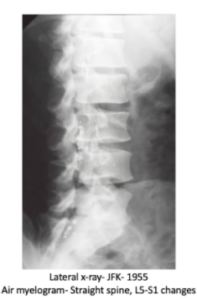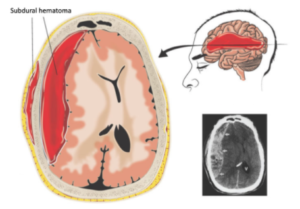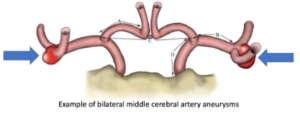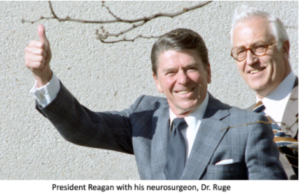 We tend not to hear much about Presidential health, even though nearly half of them in our nation’s history have had significant illnesses or injuries while in office. In 1893, Grover Cleveland underwent a “craniotomy-like” procedure. During his second term as President and on the brink of a Depression, he had a large tumor on the roof of his mouth. To avoid panic, he had the tumor, close to the base of his skull, secretly removed. He announced a four-day fishing trip on a friend’s yacht, where 6 oral surgeons performed the surgery, on a moving boat, in about 90 minutes. This left no visible scar for anyone to see and the information was not released to the public until 1917. Woodrow Wilson had a major stroke in 1919 nearly completely incapacitating him. His wife, Edith, secretly ran our country, pre-screening all matters of state and functionally running the Execute branch, from inside the White House until his term ended in 1921. (Yes, our nation essentially has already had its first female president, handling our immediate post-World War I affairs for 2 years). And Wilson’s successor, Warren Harding, died in office in 1923. His wife declined an autopsy. FDR had polio (a virus destroying part of the spinal cord) and was wheelchair-bound when he took office in 1932. He even admitted his unlikely electability if the public had seen him, benefiting greatly from TV not being widely introduced until 1939. He gained widespread popularity and confidence through his radio-broadcast fireside chats, so his disability didn’t faze the public years later when visible, especially when he appeared fragile towards the end of World War II. But he too died in office, in his case from an intracerebral hemorrhage in 1945, leaving Truman to finish fighting the Nazis with Stalin and Churchill. JFK’s successor Lyndon Johnson, had gall bladder surgery while in office in 1965. He chose to have surgery on a Friday so it wouldn’t affect the stock market and he could recover before telling the press the following Monday. He flaunted his fresh scar and Wall Street boomed. Release of health records by Presidential candidates, or even after their term, is not standardized in our country, despite the public feeling the need to know. It may be surprising to learn that numerous Presidents have undergone neurosurgical procedures at some point in their life.
We tend not to hear much about Presidential health, even though nearly half of them in our nation’s history have had significant illnesses or injuries while in office. In 1893, Grover Cleveland underwent a “craniotomy-like” procedure. During his second term as President and on the brink of a Depression, he had a large tumor on the roof of his mouth. To avoid panic, he had the tumor, close to the base of his skull, secretly removed. He announced a four-day fishing trip on a friend’s yacht, where 6 oral surgeons performed the surgery, on a moving boat, in about 90 minutes. This left no visible scar for anyone to see and the information was not released to the public until 1917. Woodrow Wilson had a major stroke in 1919 nearly completely incapacitating him. His wife, Edith, secretly ran our country, pre-screening all matters of state and functionally running the Execute branch, from inside the White House until his term ended in 1921. (Yes, our nation essentially has already had its first female president, handling our immediate post-World War I affairs for 2 years). And Wilson’s successor, Warren Harding, died in office in 1923. His wife declined an autopsy. FDR had polio (a virus destroying part of the spinal cord) and was wheelchair-bound when he took office in 1932. He even admitted his unlikely electability if the public had seen him, benefiting greatly from TV not being widely introduced until 1939. He gained widespread popularity and confidence through his radio-broadcast fireside chats, so his disability didn’t faze the public years later when visible, especially when he appeared fragile towards the end of World War II. But he too died in office, in his case from an intracerebral hemorrhage in 1945, leaving Truman to finish fighting the Nazis with Stalin and Churchill. JFK’s successor Lyndon Johnson, had gall bladder surgery while in office in 1965. He chose to have surgery on a Friday so it wouldn’t affect the stock market and he could recover before telling the press the following Monday. He flaunted his fresh scar and Wall Street boomed. Release of health records by Presidential candidates, or even after their term, is not standardized in our country, despite the public feeling the need to know. It may be surprising to learn that numerous Presidents have undergone neurosurgical procedures at some point in their life.
The most notable would be John F. Kennedy. If you are thinking he underwent a craniotomy (brain surgery) after the assassination at 12:30pm November 22, 1963, he did not. (Neither did Abraham Lincoln- although surgeons repeatedly probed Lincoln’s head wound with their finger to allow blood to escape and lower his intracranial pressure… When the bleeding stopped he developed increased brain pressure and respiratory distress). JFK was brought to Parkland Memorial Hospital and underwent an emergent tracheostomy, but by 12:57 he was pronounced dead without further intervention. Of course there is a bit of conspiracy theory around this. At the time, there was no 25th Amendment in our Constitution to lay forth the rules of succession if the President could not perform duties of office. If JFK had somehow survived, albeit in a vegetative state following Oswald’s gunshot wounds, our nation would have been in a good old-fashioned pickle, since he couldn’t be removed as President but couldn’t serve as President. The 25th Amendment wasn’t introduced until January 6th, 1965, but now seems to exist solely as callous propaganda by each opposition party. There are some who say aggressive surgery may have been withheld to avoid this scenario… somewhat of a euthanasia option… allowing JFK to quickly pass, and Johnson to assume the Presidency. You’ve got to admit, by today’s standards at least, the short time interval in which JFK was a full functioning president at noon to his body leaving Parkland hospital in a hearse at 2pm. Of course few survived gunshot wounds to the head in 1963. Case in point… Robert Kennedy underwent craniotomy for his wound in 1968 but still died from severe brain injury.
JFK had chronic back problems. This likely started following a Harvard football match in 1937. He treated this conservatively, but with little success. While JFK was in the US Naval Reserve, the pain worsened following multiple subsequent injuries. In 1944, against the advice of Mayo surgeons, he underwent a L4-5 and L5-S1 decompression in Boston. However, surgery only provided short term relief and he had a suspected disc re-herniation 2 weeks later requiring exploratory reoperation. Unfortunately, this sent Jack down a path of life-long chronic back pain. Retrospectively, some physicians reviewing his pre-and postoperative films agree with Mayo and suggest Kennedy had “a radiographically normal-appearing lumbar spine” in 1944. He may have never needed the original surgery. Kennedy even once wrote:
“In regard to the fascinating subject of my operation … I think the doc should have read just one more book before picking up the saw”
 From 1946-1952, he tried bracing, but later underwent a L5-S1 fusion in 1954, possibly including his sacroiliac joint. This was one of the earliest attempts at spine fusion. He suffered a postoperative urinary tract infection leading to a coma, so severe that Senator Kennedy was actually read his last rites. He also developed an incisional staphylococcal infection, requiring spinal instrumentation removal in 1955. JFK underwent a fourth and final surgery in 1957 to washout and eradicate the persistent infection, however we was left with spinal osteomyelitis, which is an infection of the spine bones that can be painful. He tried chronic pain medications, including methamphetamines, from a quack of a guy Max Jacobson, nicknamed, “Dr. FeelGood”. (Adolf Hitler also may have taken methamphetamines for chronic flatulence… the deleterious effects of these drugs was not known at the time). A Secret Service handler once wrote,
From 1946-1952, he tried bracing, but later underwent a L5-S1 fusion in 1954, possibly including his sacroiliac joint. This was one of the earliest attempts at spine fusion. He suffered a postoperative urinary tract infection leading to a coma, so severe that Senator Kennedy was actually read his last rites. He also developed an incisional staphylococcal infection, requiring spinal instrumentation removal in 1955. JFK underwent a fourth and final surgery in 1957 to washout and eradicate the persistent infection, however we was left with spinal osteomyelitis, which is an infection of the spine bones that can be painful. He tried chronic pain medications, including methamphetamines, from a quack of a guy Max Jacobson, nicknamed, “Dr. FeelGood”. (Adolf Hitler also may have taken methamphetamines for chronic flatulence… the deleterious effects of these drugs was not known at the time). A Secret Service handler once wrote,
“Suddenly JFK, who had entered the office tired and weak, had a bounce in his step and could move more easily, despite the pain that he lived with every day of his life. He felt stronger, cool, focused and very alert… almost as if the patient had become another person.”
It serendipitously was methamphetamines which likely improved his performance in the first-ever televised Presidential debate, against Nixon, in 1960. Prior to the debate, Kennedy summoned Jacobson, and was described as, “complaining in a voice barely above a whisper of extreme fatigue and lethargy”. After the injection, Jack felt so good he refused make-up, feeling high as a kite and brandishing his California tan. The elder Nixon, who was also tired on the campaign trail and nursing his own infected knee, reflexively refused make-up at the counsel of his advisors, not wanting to look “unmanly” or “made up” when Kennedy wasn’t. Nixon’s sweaty, pale and terribly exhausted appearance put Kennedy to the White House in 1961. But when he got there, he brought along the first female White House physician, specifically because she developed, and frequently provided Kennedy with, spinal trigger point injections. Despite this, JFKs back symptoms still negatively impacted his Presidency. He continued to meet with Dr. FeelGood in private, under the pseudonym, “Mrs. Dunn”, but the methamphetamines occasionally backfired. This was apparent by a poor performance at the crucial Vienna Summit in 1961 with Soviet Premier Nikita Khrushchev. The KGB infiltrated Jacobson’s office as was aware of JFK’s meth addiction and use before important meetings. The Soviet leader showed up intentionally late, knowing Kennedy’s typical dose of methamphetamine would be wearing off, so Kennedy actually overdosed, leading to borderline psychosis when the two leaders sat down. This couldn’t have been a worse time in the wake of the Bay of Pigs fiasco.
By 1962, JFKs x-rays showed persistent L5-S1 narrowing and loss of normal lumbar lordosis. At the time of his assassination in 1963, he was chronically wearing a back brace and taking steroid injections. Even if modern neurosurgery could have treated his head shot, the chronic steroids may have prevented his healing. But some hypothesize it was Kennedy’s back brace leading to his ultimate demise. The tight corset held him upright after the second magic-bullet to his neck, enabling the kill shot to the head. Without a brace, he may have slumped forward and avoided the mysterious third shot.
 Ronald Reagan underwent a burrhole craniotomy for a subdural hematoma in 1996. He had been falling frequently leading to pressure on his brain from a bleed. He recovered well, but passed in 2004 presumably from Alzheimer’s related pneumonia. Of course, Reagan suffered frequent memory lapses and bouts of confusion while President, exemplified in the 1984 Presidential debates and his 1990 Iran-Contra testimony. About three years into his first term many thought Reagan showed signs of cognitive dysfunction, possibly prefacing Alzheimer’s. A fairly famous 1987 news article was titled, “Is Reagan Senile?”, all-the-while his private physicians were saying he was fine. Of course, the Iran-Contra debacle, in which the US traded arms secretly to Iran in exchange for hostages, may have had other neurologic origins. The deal was signed by Reagan while still in the hospital, immediately following a surgery to remove malignant colon polyps. On the day of surgery, Reagan invoked the 25th Amendment during the 3 hour surgery, but assumed power back from Bush senior the next day. During the week he spent at Bethesda hospital, Reagan’s national security advisor Bud McFarlane, approached him with the deal, which he approved while on narcotics. The deleterious cognitive effects of opiates and anesthesia on a 74 year old is known, and can continue for weeks to years.
Ronald Reagan underwent a burrhole craniotomy for a subdural hematoma in 1996. He had been falling frequently leading to pressure on his brain from a bleed. He recovered well, but passed in 2004 presumably from Alzheimer’s related pneumonia. Of course, Reagan suffered frequent memory lapses and bouts of confusion while President, exemplified in the 1984 Presidential debates and his 1990 Iran-Contra testimony. About three years into his first term many thought Reagan showed signs of cognitive dysfunction, possibly prefacing Alzheimer’s. A fairly famous 1987 news article was titled, “Is Reagan Senile?”, all-the-while his private physicians were saying he was fine. Of course, the Iran-Contra debacle, in which the US traded arms secretly to Iran in exchange for hostages, may have had other neurologic origins. The deal was signed by Reagan while still in the hospital, immediately following a surgery to remove malignant colon polyps. On the day of surgery, Reagan invoked the 25th Amendment during the 3 hour surgery, but assumed power back from Bush senior the next day. During the week he spent at Bethesda hospital, Reagan’s national security advisor Bud McFarlane, approached him with the deal, which he approved while on narcotics. The deleterious cognitive effects of opiates and anesthesia on a 74 year old is known, and can continue for weeks to years.
Jimmy Carter also underwent burrhole craniotomy for subdural hematoma in 2019. He is currently 96. George W. Bush had a spine surgery in 2013 for “disc problems”. Little is known about Bush’s condition or the exact details of that surgery. We’ve now had 45 elected US Presidents of the Continental Congress, and about 10 unofficial pre-Washington Presidents. It’s difficult to know if any of the other prior had brain or spine care.
 However, the most notable neurosurgical intervention may be exemplified in our upcoming 46th President, Joe Biden, who underwent bilateral craniotomies. Little was mentioned about Biden’s health leading up to the 2020 election, although his story was described by him in prior interviews. He suffered a left-sided ruptured cerebral aneurysm in 1988 and underwent a craniotomy for clipping. A few months later, Biden underwent
However, the most notable neurosurgical intervention may be exemplified in our upcoming 46th President, Joe Biden, who underwent bilateral craniotomies. Little was mentioned about Biden’s health leading up to the 2020 election, although his story was described by him in prior interviews. He suffered a left-sided ruptured cerebral aneurysm in 1988 and underwent a craniotomy for clipping. A few months later, Biden underwent  craniotomy on the other side of his head for a second, but unruptured, aneurysm. He took a seven month leave from the Senate, and has described it in blunt terms, saying, “they literally had to take the top of my head off”. It is unclear at this point how often Biden is screening for aneurysm reappearance, which can recur after clipping up to 0.5% of the time. We now know he is also on chronic blood thinners for a prior pulmonary embolus. The use anticoagulants doubles the risk of spontaneous brain hemorrhage. It is unclear if the use of anticoagulants with a history of aneurysms increases risk of re-rupture.
craniotomy on the other side of his head for a second, but unruptured, aneurysm. He took a seven month leave from the Senate, and has described it in blunt terms, saying, “they literally had to take the top of my head off”. It is unclear at this point how often Biden is screening for aneurysm reappearance, which can recur after clipping up to 0.5% of the time. We now know he is also on chronic blood thinners for a prior pulmonary embolus. The use anticoagulants doubles the risk of spontaneous brain hemorrhage. It is unclear if the use of anticoagulants with a history of aneurysms increases risk of re-rupture.
Considering the neurologic and neurosurgical conditions that have plagued so many US Presidents, it’s a bit surprising the White House physician staff does not perpetually include a neurosurgeon. This role is usually been filled by an emergency medicine, family medicine or internal medicine physician, most of whom have also been US military. Dr. Daniel Ruge, MD, who served as Reagan’s White House physician, was the only neurosurgeon in history to serve this role. Of interest, when Reagan was shot in the chest in 1981, it was Dr. Ruge’s insistence that standard trauma protocols be followed which may have saved Reagan’s life. Most White House physicians wouldn’t have done this. The standard algorithm would be to consult the heads of all departments, possibly delaying care, or even resulting in transfer to another hospital. But Ruge kept Reagan at GW, even allowing resident trainees to participate.
“If this was anyone else coming in with a gunshot wound, what is the first thing you’d do? Then that is what we are going to do”
It was basic trauma protocols, executed by schmo residents, which diagnosed Reagan’s dropped lung, and hastened the President’s recovery. It was an unorthodox White House physician acting in unorthodox fashion to save the day.






